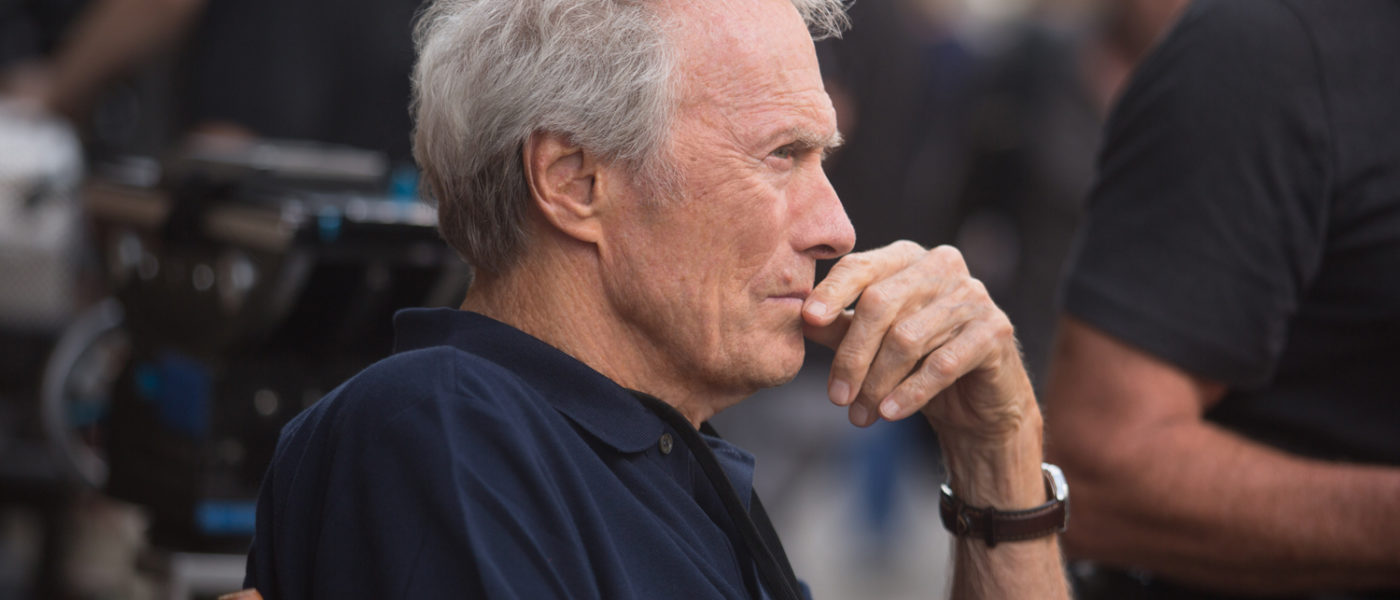Iconic Star of Few Words is a Prolific Director of Fewer Takes
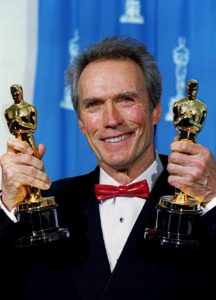
Eastwood after the 65th Academy Awards
Clint Eastwood was famously a nobody before he got to be a man with no name. In the middle of riding cool in the saddle on the classic TV western Rawhide, he spent a fateful summer in Spain shooting an Italian western for Sergio Leone, and it shot him straight to the front of the corral, fame wise.
He didn’t know it, but he and Leone were reviving a waning genre by dispensing with the ’50s slow descent into morose psychology and amping up the showier florals of the genre inside double-barrel widescreen compositions. Upon the stateside release of A Fistful of Dollars in ’67, Eastwood was suddenly an international star. From there he slowly built a career on his lanky calm and wind-burned looks. There’s just enough sarcasm in his outright meanness to pass for scrub-brushed charm, and you let him in a little, and then you like him.
He’s been steadily productive now for decades, becoming one of the most prolific of modern mainstream directors
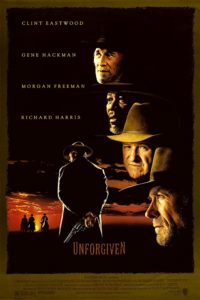 He played cowboys, cops, cowboy-cops, and a couple WW2 soldiers before taking the reins of his first movie, Play Misty For Me (below). Running alongside his acting career, and very often overlapping it, his directing career is such a mixed bag of scattered subjects and genres, it can only be categorized under the highly academic term “hodge podge”. But he’s been steadily productive now for decades, becoming one of the most prolific of modern mainstream directors, garnishing his mantle with two Oscars for directing: Unforgiven and Million Dollar Baby, both also Best Picture winners.
He played cowboys, cops, cowboy-cops, and a couple WW2 soldiers before taking the reins of his first movie, Play Misty For Me (below). Running alongside his acting career, and very often overlapping it, his directing career is such a mixed bag of scattered subjects and genres, it can only be categorized under the highly academic term “hodge podge”. But he’s been steadily productive now for decades, becoming one of the most prolific of modern mainstream directors, garnishing his mantle with two Oscars for directing: Unforgiven and Million Dollar Baby, both also Best Picture winners.
And now, Clint Eastwood makes our day at ZekeFilm. We’ve each picked a movie directed by Eastwood we’ve not seen. Though most still think of him as either of his two most iconic roles: said “Man With No Name” and the near-fascistic rogue cop Dirty Harry, this handful of titles shows a ranging curiosity beneath the pistol-wrangling façade.
– Robert Hornak
Play Misty for Me
1971, Universal Pictures, dir. Clint Eastwood
by Jim Tudor
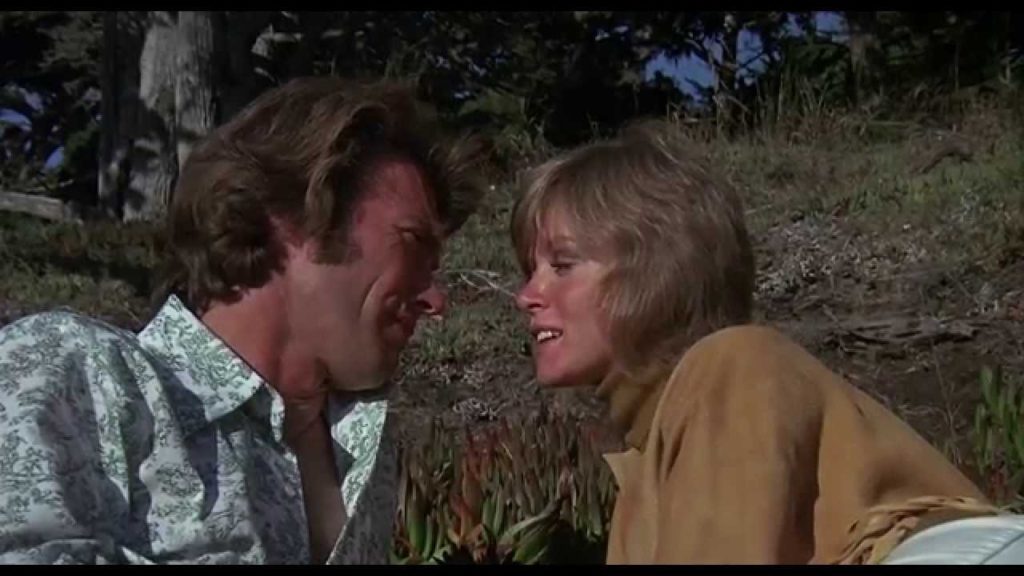
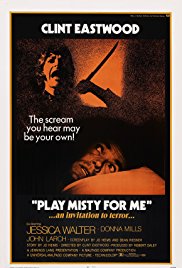 With an unmistakable voice, in more ways than one, it’s somehow fitting that Clint Eastwood would make his directorial debut in a film in which he plays a radio personality.
With an unmistakable voice, in more ways than one, it’s somehow fitting that Clint Eastwood would make his directorial debut in a film in which he plays a radio personality.
They say that radio, for whatever reason, brings out the crazies. If Clint Eastwood’s debut directorial effort is any indication, they couldn’t be more right. Jessica Walter plays a woman obsessed with KRML disc jockey Dave Garver, played by a spry Eastwood. Garver is a man of his time and place, holding to an open relationship with a longtime gal pal with benefits (Donna Mills). When a one-night fling with Walter’s character sends her into Glenn Close Fatal Attraction territory, things get tense, deadly, and even stabby.
It’s been widely reported that Eastwood never yells “action” while directing, instead opting for a more settling cue of “okay”. Whether or not he’d adopted this practice at this earliest of points in his esteemed directing career, one thing is for sure- there are long stretches where the lack of action is felt. That’s not to say that Play Misty for Me is a boring movie-ultimately, it becomes quite thrilling. But the art of pacing and trimming the fat is something he’d yet to perfect.
An odd observation in this first-time viewing: The two main women both have tightly cropped helmet hair, whereas Eastwood gets to sport the wildest fly-away hair of his career. Also, Eastwood comfortably wearing big-collared patterned polyester shirts and bell bottom jeans the whole time is yet another naturally time capsuling element of this otherwise fairly timeless story- no sin unto itself, but a point of attention nonetheless. More glaring in its omission in a Clint Eastwood film of this era in his career: a gun. Rather, the he gets to, for the very first of many times, indulge his deep love of jazz music. The characters even visit the actual Monterey Jazz Festival, and we all get to watch a live performance for several minutes.
Play Misty for Me is a film that’s compellingly in love with its visual textures, dwelling prolongedly at times on the uneven ripples of the ocean, the sand on the beach, the leaves of the woods. And that’s not to mention Garver’s house, itself an isolated, dark, labyrinthine dwelling sporting all manner of antiques, art, the occasional floor-to-ceiling barky tree trunk(!), and some always interesting crinkling reflective gold wallpaper, left over from the old world. In short, it’s a production designer’s dream.
Yes, Eastwood’s voice is unmistakable, both his physical speaking voice, and his authorial voice. Somewhat unpredictable, but ever unmistakably his own, the iconic patriarch has picked up the torch of his own experiential influences, Sergio Leone and Don Siegel (who makes his own acting debut as a bartender in Misty), breaking new ground, pushing new boundaries, and ruminating on things to do with death.
The Outlaw Josey Wales
1976, Warner Bros., dir. Clint Eastwood
by Robert Hornak

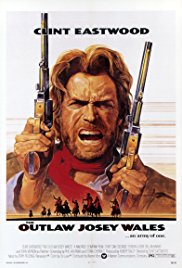 I’d lagged on this one due to the overlap of western with Civil War story, a conflation that usually bores me for reasons unknown, but here we have Eastwood melding his trademark taciturn cowboy and his equally spare but evolving shooting style with enough panache to make one of his better, more meaningful oaters, as far as you’ll allow cowboy movies to be meaningful, as I do. This one’s about a near mythically-skilled killer-with-a-heart-of-gold running from a cache of military men sent to kill him – essentially a Rambo story made in the year of Rocky about war vets lost without a country. Clint plays Wales, whose family is burned up by bad guys in the opening five minutes, providing all the justification you need for a movie’s worth of revenge killing. He then channels his rage into the south’s fight against that pesky Union invasion, until the government itself is nipping at his spurred heels. He ‘s a simple man with his broken heart in the right place and his guns aimed as square and sure as the tabacky spit he splats on the forehead of those slain by his trigger finger.
I’d lagged on this one due to the overlap of western with Civil War story, a conflation that usually bores me for reasons unknown, but here we have Eastwood melding his trademark taciturn cowboy and his equally spare but evolving shooting style with enough panache to make one of his better, more meaningful oaters, as far as you’ll allow cowboy movies to be meaningful, as I do. This one’s about a near mythically-skilled killer-with-a-heart-of-gold running from a cache of military men sent to kill him – essentially a Rambo story made in the year of Rocky about war vets lost without a country. Clint plays Wales, whose family is burned up by bad guys in the opening five minutes, providing all the justification you need for a movie’s worth of revenge killing. He then channels his rage into the south’s fight against that pesky Union invasion, until the government itself is nipping at his spurred heels. He ‘s a simple man with his broken heart in the right place and his guns aimed as square and sure as the tabacky spit he splats on the forehead of those slain by his trigger finger.
Lest he be incorrectly perceived as a bad guy himself, Wales does the Save the Cat thing with a young acolyte there to aid in his escape from Union soldiers. It’s the friendship/tutelage with this brash young gun that calls to mind Unforgiven (1992) – and this movie makes me like that movie even more. This section of Josey Wales is partly the story of lost innocence, where Unforgiven is that also, but it further dismantles the theme to prove that even righteous violence comes with a price higher than life – it steals the soul itself. Then, once the kid’s usefulness as a light on Wales’ basic goodness is fulfilled, the script kills him with a festered gunshot wound and the story promptly offers a backup sidekick: Chief Dan George, regaled in top hat and philosophy. With George comes the fulcrum shift in the point of the movie, which becomes the illumination of the devastation of Native American populations in the 19th century. Both men are aligned against the white man, and America as a broken concept is left as the central antagonist, fitting the film easily in the category of other bicentennial offerings like Network, Taxi Driver, and All the President’s Men.
As a director, Eastwood is clearly having an easy, fun old time, treating his story as a grand tour through virtually every iconic genre totem, if you will, of the classic western, from hotels and saloons to horse treks through river, snow, open wilderness, and desert, all of it under cottony blue Texas skies. But too often it’s as though he left the bounce cards at the last campfire – so many shadowed faces under brightly lit hats…And he has a strange tick, maybe once per reel, asking his actors in close up to sometimes leave frame in a slow, lateral move that makes them look like they’re being pulled away on a skateboard dolly. No mind, the movie’s highly entertaining in that doleful, dusty, old west way. By the end of the movie, the initial revenge for his family’s death might be long forgotten, so the motive’s as muddy as the Brazos, but the upside is getting to watch an actor perfectly matched to his role – again.
Million Dollar Baby
2004, Warner Bros., dir. Clint Eastwood
by Taylor Blake
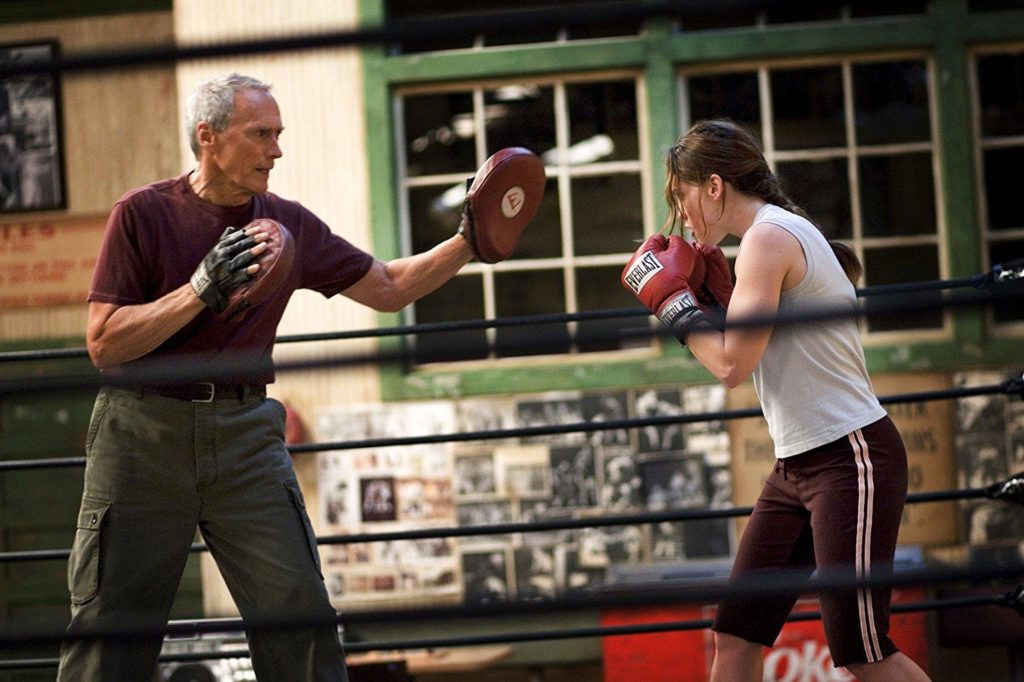
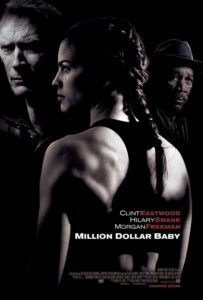 What a horrible, horribly well-made movie.
What a horrible, horribly well-made movie.
I’m adding Million Dollar Baby to my publicly documented list of movies I enjoyed until the last act. Without spoiling the ending for this Best Picture winner, I’ll say you’re better off cutting it short at the 90-minute mark, just before a major plot point turns the last 45 minutes into a different story with a darker tone, depressing spirit, and disheartening message.
What makes that ending even more disappointing is that the first two acts are triumphant. In the real world, I find boxing boring and pointless, but with Clint Eastwood’s direction, I find the leans and pivots and swings consuming. The script gives insight into why our fighters make each move, and the camera knows how to follow them. Unlike Marvel superhero fights that are easy to tune out as one continuous BIFF!WHAM!POW!, I couldn’t look away from every hit, punch, and sock in the ring.
While my exposure to Eastwood’s work is admittedly limited (I had plenty of films to choose from for this month’s Admission), his skill as an actor’s director shows. All of his actors appear as comfortable on screen as he appears to be in his very high-waisted cargos, and the camera lingers long enough to let them rest in the emotional complications of each moment. Morgan Freeman and Hilary Swank’s Oscars for their roles and Eastwood’s for directing come as no surprise and with no dispute from me.
But then—then. All the goodwill Eastwood earned by pulling my heart into a world I never knew I could care about came crashing down. My tear-tinged pillow wished I’d stayed sheltered from this horrible ending, and I can’t in good conscience write about Million Dollar Baby without warning you that you’ll probably finish feeling dark, depressed, and disheartened.
What a horrible, horribly well-made movie.
Invictus
2009, Warner Bros., dir. Clint Eastwood
by Madeline Brophy
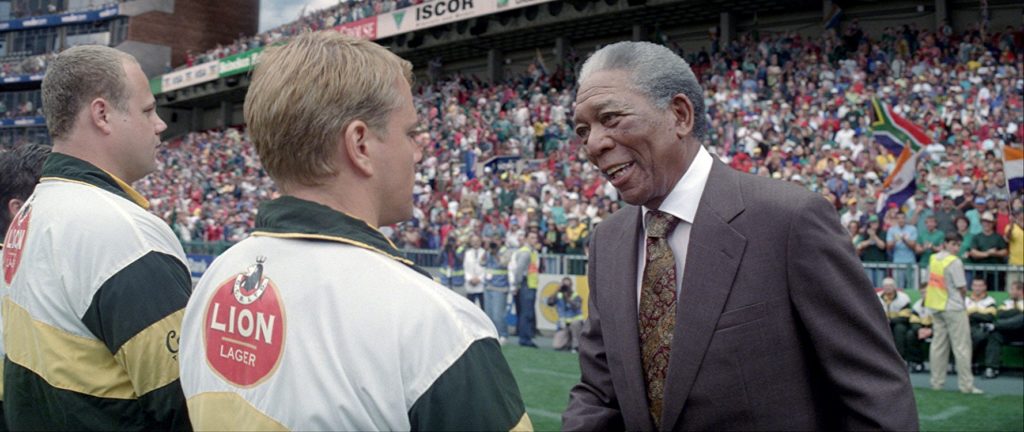
 I am the master of my fate. I am the captain of my soul.
I am the master of my fate. I am the captain of my soul.
Those are some of the words that helped Nelson Mandela endure over 27 years in prison, an image Francois Pienaar, Captain of the South African Springboks Rugby team, cannot get out of his head before the world championships. It is also the poem of the film’s namesake, “Invictus”, by William Ernest Henley.
The best part about this film is that it’s not a sports movie. Sure it involves sports and viewers experience a few rugby scenes, some in particular more moving and nerve-wracking than others, and some shot at a funny frame rate (if you ask me). If your intention is to experiecne another thrilling sports drama, you may be disappointed with this one. However, this is a movie worth watching to witness a country and a community as they labor to heal the wounds wrought by racial tension in the post-Aparteid era.
Clint Eastwood stays behind the camera this time and directs Morgan Freeman as Nelson Mandela after recently becoming the first black President of South Africa and Matt Damon as Francois Pienaar, Captain of the Springboks Rugby team.
Morgan Freeman is at his finest, managing Mandela’s frustration and hope for the country with grace and stature, and making me long for the days when leaders exhibited such poise. Matt Damon is a soft-spoken and graceful leader as the rugby team captain. However, while viewers get a glimpse into Pienaar’s family life, I would have liked for Eastwood to have explored it further.
Besides the abrupt music changes that occur quite frequently in the film, as well as moments of grunting towards the end (from the Rugby players), it is a well-executed and paced 133 minute film. Eastwood exhibits his fine ability to showcase the juxtaposition of a country both for and against Mandela in the tumultuous times of the 90’s. Eastwood is especially talented in montage shots that include gatherings of black and white South Africans celebrating the Springbok’s 1995 world cup championship win. I also enjoyed watching the Springbok’s team bond and train with the different communities.
In addition to unification, Invictus is also a story of forgiveness. This is true on Mandela’s part of course, as he serves a country that once beat, berated, and condemned him to prison, but also in his security cabinet, specifically the office that has to protect him. Immediately there’s a racial divide addressed in the film, as the black security officers are hesitant to trust the white guards, fearful of their motivations and loyalty. Ultimately they have to trust each other and that only comes with working together, learning about one another, and respect.
In a movie seemingly about sports, Invictus highlights a country’s progression rather than just the athletes journey to victory.
J.Edgar
2011, Warner Bros., dir. Clint Eastwood
by Erik Yates
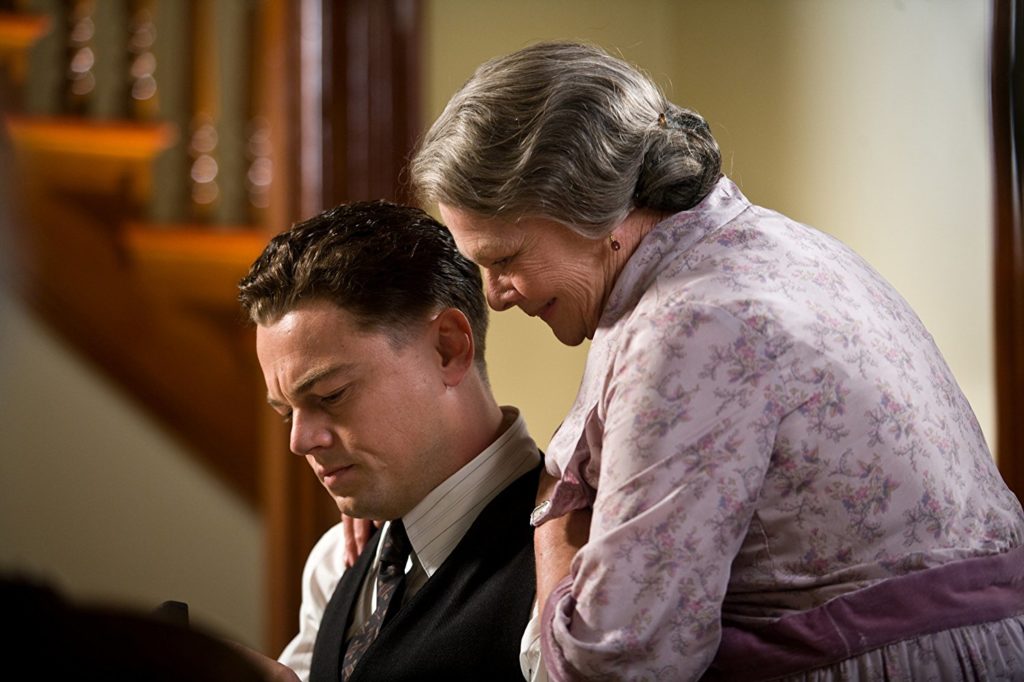
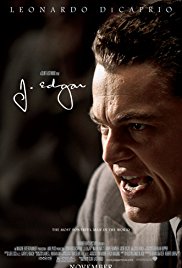 One of the more recent of Clint Eastwood’s films, J.Edgar highlights the often controversial former F.B.I. director, J. Edgar Hoover, played by Leonardo DiCaprio. Delving into his personal life, the film focuses on his overly close relationship with his mother Annie (Judi Dench), his failed attempt at romance with Helen Gandy (Naomi Watts) who goes on to be his secretary and closest confidant, guarding Hoover’s famed secretive personal files. The film also shows his complicated relationship with his second in command, Clyde Tolson (Armie Hammer), a closeted homosexual who would be a confidant and companion to Hoover for the rest of his life.
One of the more recent of Clint Eastwood’s films, J.Edgar highlights the often controversial former F.B.I. director, J. Edgar Hoover, played by Leonardo DiCaprio. Delving into his personal life, the film focuses on his overly close relationship with his mother Annie (Judi Dench), his failed attempt at romance with Helen Gandy (Naomi Watts) who goes on to be his secretary and closest confidant, guarding Hoover’s famed secretive personal files. The film also shows his complicated relationship with his second in command, Clyde Tolson (Armie Hammer), a closeted homosexual who would be a confidant and companion to Hoover for the rest of his life.
The film plays with the tension of the exact nature of Hoover and Tolson’s relationship, showing both Hoover rejecting a pass from Tolson, while also demonstrating that there was genuine love and devotion as well. The oft-rumored notion that J. Edgar liked to dress up in women’s clothing is given a brief mention with Eastwood connecting it more to trying to capture a memory of his then deceased mother, rather than some long-standing fetish. The entire film jumps around in time as Hoover relays the story of his career and life to an author who is writing a book on him. Throughout the process, Hoover’s memories thrust him into a more and more prominent role in cases he personally was not involved in, outside his role as director. This includes the famous Lindbergh case, and taking more credit for the killing of John Dillinger, firing the agent who did, so as to shape the narrative of his importance in the F.B.I. after being embarrassed by a Senate committee hearing.
In typical Eastwood fashion, he would rather direct the film in a way that leaves the subject in a morally gray area, never resolving the tension. As in life, no one individual is either the villain or the hero of their own story, they are a complicated mix of both. Much praise is given to Hoover for his nearly 50-year reign as the director of the F.B.I., and for all of the good they accomplished to root out large criminal networks, establish forensic science as a means of seeking convictions over circumstantial evidence and the stopping of the practice of law enforcement officers tainting crime scenes out of ignorance of forensic evidence. Eastwood balances this praise with the presentation of an often insecure man who sought to control everything and everyone around him. Paranoid and vindictive are two other traits that loom large.
A talented cast permeates every scene, though I wish I would have learned more about Helen Gandy. The film ends without much resolve, as Hoover went to his grave with most of his most speculated secrets being lost with him, due to the obedient actions of his closest confidant. Leaving the mystery of one of the most controversial and important figures of the 20th Century in place seems to be an appropriate way to end the film and is a great addition to Eastwood’s body of work as a director. While not among his strongest directorial films, it is a consistently good one that deserves to be seen.
The 15:17 to Paris
2018, Warner Bros., dir. Clint Eastwood
by Sharon Autenrieth

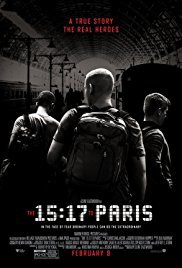 Anthony Sadler, Alek Skarlatos, and Spencer Stone became famous for doing a brave, good thing. Unfortunately, the movie that Clint Eastwood made about them, while arguably brave, is definitely not good.
Anthony Sadler, Alek Skarlatos, and Spencer Stone became famous for doing a brave, good thing. Unfortunately, the movie that Clint Eastwood made about them, while arguably brave, is definitely not good.
Sadler, Skarlatos, and Stone were childhood friends, now young men vacationing in Europe when destiny appointed them to confront a terrorist on a high speed train between Amsterdam and Paris (and The 15:17 to Paris really hammers the destiny ange, by the way). A Moroccan terrorist, Ayoub El Khazzani, exited a bathroom on the train armed with an assault rifle, a pistol, a box cutter, and 270 rounds of ammunition. The outcome might have unspeakably tragic if not for the courage of several passengers – including the three young Americans who – between them – charged and subdued the gunman, and saved the life of an injured passenger.
It’s a great, but short story. Clint Eastwood made a few strange and jarring decisions in translating the event to film. One was to pad the 15 minutes of heroism with 80 or so minutes of Sadler’s, Skarlatos’, and Stone’s life stories, and with their European vacation. More on that in a moment. The second, nearly fatal decision, was to have the friends play themselves on screen. This was the arguably brave bit – either a bold experiment, or a stunt. Now, I’ve seen Anthony, Alek, and Spencer interviewed. They seem like genuinely kind, humble, likeable young men. But they are not, sadly, actors (new SAG cards notwithstanding). It’s not unprecedented to cast “real” heroes as themselves, but not everyone is an Audie Murphy or a Harold Russell – Google them, if those names mean nothing to you. Cynics and movie-haters will tell you otherwise, but acting is a craft. Eastwood did no favors for the men at the center of The 15:17 to Paris by rejecting their suggestion that they take acting lessons (he wanted them to be natural, and trust me, that backfired), nor with his usual directorial style of doing only one or two takes. Anthony Sadler and Spencer Stone are just barely passable as actors. Poor Alek Skarlatos is awful. Watching the three of them together is cringe-inducing.
But if the acting was the only problem – if only! Somehow, the script, by Dorothy Blyskal, makes things significantly worse. The childhood scenes are predictable, and the Alek’s and Spencer’s mothers, played respectively by Jenna Fischer and Judy Greer, are given some groan-worthy lines to make sure we know that God is orchestrating these mischievous boys’ futures. After the friends reach adulthood, we’re allowed to see them struggling to find their places in the world – Alek in the Army National Guard, Spencer in the Air Force, and Anthony as a college student.
But then – why??? – Eastwood devotes a long chunk of the movie to the friends vacationing in Europe. Do we really need to see an entire episode of Bros Abroad in order to appreciate why Anthony, Alek, and Spencer were on that Paris-bound train? Do we need to see Anthony taking every selfie with his new selfie stick? See them consume every pint in every bar they visit? And worst of all, hear their commentary on every sight they see in their sightseeing? We’re given lines like, “We made it to the Coliseum, baby! Can you believe how big it is?” and “This is it, baby! The Trevi Fountain!” As I said, I’ve seen these men interviewed and they seem smarter than this dialogue. But maybe they’re not, and that doesn’t really matter; it doesn’t take away from their courage on the train. I just wish Eastwood hadn’t rubbed our noses, however unwittingly, in the stereotype of ignorant, oafish Americans.
As I’ve said, The 15:17 to Paris is a bad movie. There is, however, a decent message buried in the amateurish acting and the frat-boy banter. These guys were not especially extraordinary in most ways – especially Stone, around whom Eastwood centers the story. Spencer Stone was a pesky, hyper kid who struggled to make it into the Air Force and failed out of his choice of specialization. On that August day, on a moving train, none of that mattered. Stone was a perfectly ordinary guy in every respect except that he believed it was his responsibility to stop people from dying – and so he did. As much as I love superhero movies, we probably need to be reminded now and then that most acts of courage and self sacrifice are performed by people who are far from superhuman.
Letters From Iwo Jima
2006, Warner Bros., dir. Clint Eastwood
by Jeffrey Knight
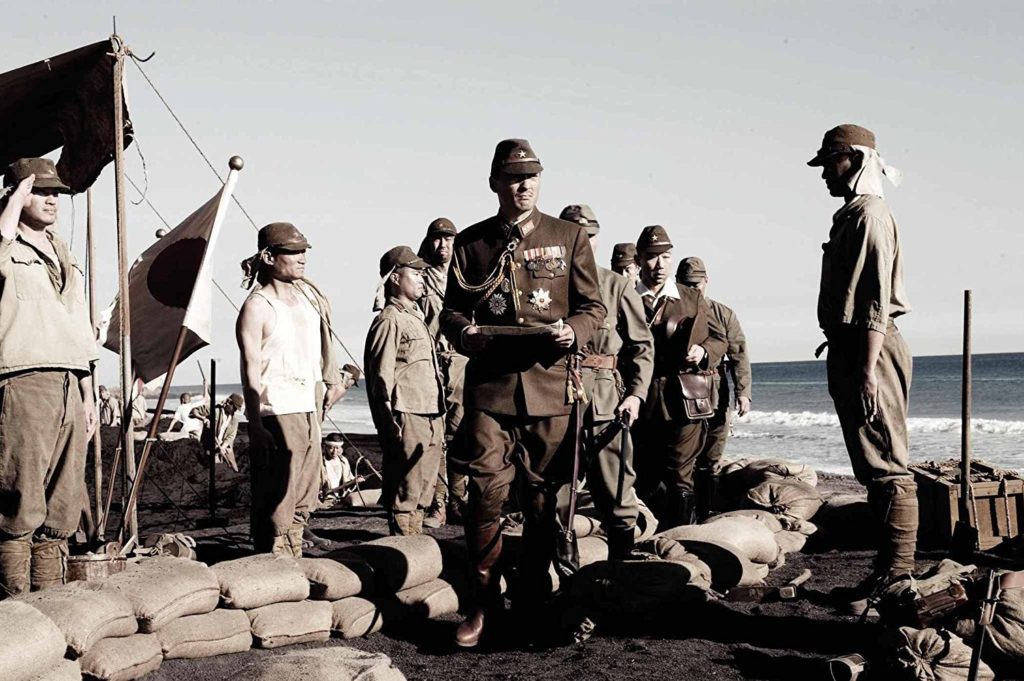
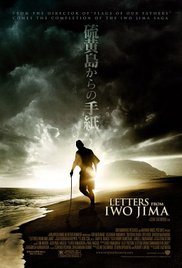 If anybody was going to make an epic WWII movie on a budget, it would be Clint Eastwood. In fact, Eastwood’s productions are so efficient and economical, that he was able to make two such films- Flags of Our Fathers and Letters From Iwo Jima. He got the most out of his time on location in the Pacific by filming the two movies concurrently.
If anybody was going to make an epic WWII movie on a budget, it would be Clint Eastwood. In fact, Eastwood’s productions are so efficient and economical, that he was able to make two such films- Flags of Our Fathers and Letters From Iwo Jima. He got the most out of his time on location in the Pacific by filming the two movies concurrently.
He began developing Letters while working on preproduction for Flags. He grew interested in the story of the Japanese men who were charged with defending this little island. The Battle of Iwo Jima was significant in the Pacific theater not so much for its strategic value but more so for its symbolic one. It was the first real battle of the war that was actually fought on Japanese soil. The soldiers on the island were suffering from near-constant disease and hunger. They weren’t going to be receiving any more troops or supplies than they already had, and their commander, General Kuribayasi (played in the movie by Ken Watanabe) knew full well the technical might of the forces coming for him. This was not a fight the Japanese were going to win. But they fought and they fought hard because this was their home.
“If our children can live safely for one more day,” Kuribayashi says, “It would be worth the one more day that we defend this island.” American forces expected to take the island within one week. The battle lasted five.
As an actor, Eastwood is probably best known for roles as a tough guy with nearly supernatural skills in the art of dealing violence. As a director, however, Eastwood is drawn to the little guy, the underdog who has to fight their way through seemingly insurmountable obstacles. In that light, it’s easy to see what drew him to the story of the Japanese defenders. What were these men thinking as they were facing a battle that they could not lose, but had no way to win?
It’s easy to see how a director with such an intense interest in the humanity of his characters could be drawn to this story. What’s remarkable is that Eastwood goes ahead and shoots this second movie; an American production company filming a WWII movie, where Americans are the antagonists. He then sets himself up with the challenge of shooting it in Japanese, a language that he himself doesn’t speak. Eastwood is obviously not a director afraid of challenging himself.
And that’s the whole of Eastwood’s directorial career ever since Play Misty For Me. As an actor, Eastwood has a limited range (he’s not a bad actor by any means, mind you), but the films he has produced and directed have been outstanding in terms of breadth of subject matter. The only genre he has explored multiple times is the western, and since Unforgiven he’s declared himself done with that. Even after films like White Hunter, Black Heart or Bird I don’t think anyone could see anything like Letters From Iwo Jima coming. His risks don’t always pay off (witness the casting of non-actors in the lead roles of The 15:17 to Paris), but it’s great that even at the age of 87, he’s still willing to take them.


